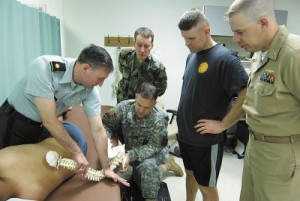 Spinal Manipulative Therapy (SMT) is one of many therapies for the treatment of low back pain. It is a worldwide, extensively practiced intervention that not specific to one scope of practice or profession. A recently published study from Rubinstein et al assessed the effects of spinal manipulative therapy (SMT) for acute low back pain to update the Cochrane Review has concluded that SMT is no more effective for acute low back pain than inert interventions, sham SMT or adjunct therapy. Conversely, a more recent study by Kuczynski et al has concluded that there is evidence to support the use of spinal manipulation by physical therapists in clinical practice.
Spinal Manipulative Therapy (SMT) is one of many therapies for the treatment of low back pain. It is a worldwide, extensively practiced intervention that not specific to one scope of practice or profession. A recently published study from Rubinstein et al assessed the effects of spinal manipulative therapy (SMT) for acute low back pain to update the Cochrane Review has concluded that SMT is no more effective for acute low back pain than inert interventions, sham SMT or adjunct therapy. Conversely, a more recent study by Kuczynski et al has concluded that there is evidence to support the use of spinal manipulation by physical therapists in clinical practice.
The first study by Rubinstein et al collated RCTs that examined manipulation or mobilisation in adults with acute low back pain (<6-week duration) up until March 13, 2011 and examined the effects for SMT versus (1) inert interventions, (2) sham SMT, (3) other interventions, and (4) SMT as adjunct therapy. 20 RCTs were identified (total participants = 2674 of which 6 (30% of all included studies) had a low risk of bias. In general, for the outcomes of pain and functional status, there is low- to very low-quality evidence suggesting no difference in effect for SMT when compared with inert interventions, sham SMT or as adjunct therapy. There was varying quality of evidence (from very low to moderate) suggesting no difference in effect for SMT when compared with other interventions. The few numbers of studies limit this evaluation and more recent research (since March 2011) may well have had an important impact on these results.
More recently Kuczynski et al examined the effectiveness of physical therapy spinal manipulations for the treatment of patients with low back pain. Studies were included if each involved: 1) individuals with LBP; 2) spinal manipulations performed by physical therapists compared to any control group that did not receive manipulations; 3) measurable clinical outcomes or efficiency of treatment measures, and 4) randomized control trials. Again 6 RCTs met the inclusion. Notable results included varying degrees of effect sizes favoring physical therapy spinal manipulations and minimal adverse events resulting from this intervention. Additionally, the manipulation group in one study reported statistically significantly less medication use, health care utilization, and lost work time.
Based on the findings of these systematic reviews there is support both for and against the use of spinal manipulation by physical therapists in clinical practice. However, physical therapy spinal manipulation appears to be a safe intervention that improves clinical outcomes for patients with low back pain.
What evidence do you have?
Read the Rubinstein et al study
Read the Kuczynski et al study
Read more about SMT in Physiopedia
Read more about Low Back Pain in Physiopedia